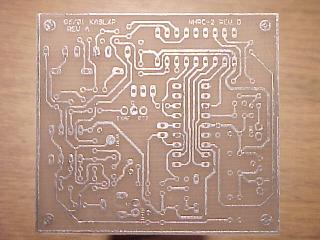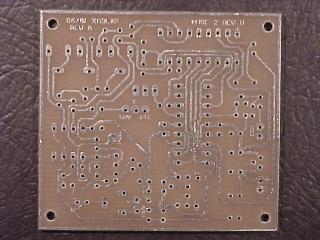 |
|
You can make printed circuit boards like this one at home for a modest expense. Invaluable to experimenters and homebrewers. |
 |
|
You can make printed circuit boards like this one at home for a modest expense. Invaluable to experimenters and homebrewers. |
Why would anyone mess around to make PCB's?
I finally bit the bullet and tooled up to make my own circuit boards at home. The idea of hand-wiring some of the projects I'd like to do has kept me from even starting them. By making my own circuit boards I opened myself up to not only being able to create and re create favorite projects, but also much more complex projects. If you've done any kind of building at all, you can appreciate how much difference it makes to stuff a pre-printed PCB versus hand wiring on perfboard. It makes building some of the projects you see in magazines much more straightforward to do. Just convert the article's schematic to a board, buy the parts and put it together. Just a few steps short of a pre-kitted project.
Preliminary Stuff
While making PCB's at home isn't particularly difficult, it's not a trivial undertaking. You need to acquire some kind of PCB layout program, and build or buy some specialized equipment. There's also a bit of a learning curve to it, especially the PCB layout tool. There's nothing stopping you from using resist-pen, or even a simple computer paint program to define the traces. The downside is that this will limit you on the complexity of the circuit you can lay out, and make it harder to incorporate changes down the line.
PCB Layout Software
There's really no point in using the etch resist pen or paint program because a commercial-quality layout tool can be had for free. It's called EAGLE PCB, put out by CadSoft. You can download for free either a Linux or Windoze version of this layout tool, whose only limitation is a maximum of one schematic page and about a 2.5x4" PCB size. This is more than enough for most hobby/ham projects, and if you need more than that, the registered version cost is very reasonable. I run the Linux version and am very happy with it. Plan on spending a few (or more) evenings getting to understand the interface and component libraries, and you will see this is a much better solution than etch markers or paint programs.
Equipment Procurement
Depending on how resourceful you are, you can spend a little or a lot on etching equipment. I wimped out and bought most of my equipment but it wasn't hard to justify after seeing the results. I'm using what's known as the "toner transfer method", where you print your board layout onto a special paper using a laser printer, then "re-fuse" the toner onto a blank copper board using a laminating machine. Then you soak the paper off, leaving the toner behind. The etchant can't eat through the toner, so any copper covered with toner remains behind as circuit traces or component pads. Seems simple, and it is. But there are a few gotchas that will make or break the success of this process, so save yourself the grief that I went through and follow along below as we go through the process of making a board.
PCB Fabrication Process Details
 |
|
|

Project Page |

Home Page |
